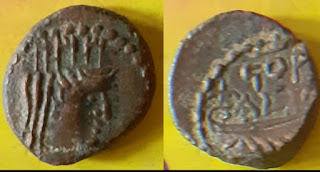Ashkelon or Ashqelon (Hebrew), also known as Ascalon (Arabic) is a coastal city in the Southern District of Israel on the Mediterranean coast. The ancient seaport of Ashkelon dates back to the Neolithic Age of 5880 BC.
Ashqelon as mentioned on "Merneptah Stele" which is an inscription by ancient Egyptian Pharoah Merneptah, discovered in 1896 at Thebes and now in the Egyptian Museum, Cairo
It has been ruled by ancient Egyptians, Canaanites (2500-1150 BC), the Philistines (1150-604 BC), the Assyrians (604-330 BC), the Babylonians, the Greeks (330-160 BC), the Romans (63-100 BC), the Persians, the Arabs and the Crusaders, until it was destroyed completely by the Mamluks in 1270 AD.
Ashkelon was prosperous from very early in the 19th century BC. In around 1200 BC, the Philistines who migrated to the coastal plain of Israel settled in five major cities. This was one of the five Philistine city-states (along with Gaza, Gath, Ekron and Ashdod). It was from this designation that the whole of the country was later called Palestine.
Palestine during the time of David and Solomon
The Bible wrote about the Philistine invasion (Amos 9 7) "Have not I brought up Israel out of the land of Egypt? and the Philistines from Caphtor...." Caphtor is the island of Cypress. The records are also inscribed in the mortuary temple of Ramses III at Madinat Habu, where they appear as ' the sea people that invaded Egypt about 1190 BC. After being repulsed by the Egyptians, they settled on the plains in the five cities known as Philistia, or the land of the Philistines.
It was subjected to Assyrian rule about 735 BC, and they ruled for about a hundred years. The Babylon empire thereafter ruled around 609 BC. Ashkelon was conquered in 604 BC, destroyed and its people taken into exile.
Subsequently the city was captured by Alexander the Great in 323 BC.
The city plays a role in biblical histories too. Ashqelon was conquered by the Arabs in 636 AD. The Jews survived the Arab conquest, however the community suffered when captured by the Crusaders in 1153 AD, and it became one of the principal ports and strongholds. It was a trading center linking Egypt with Syria and Mesopotamia.
It was eventually taken over by Saladin, who destroyed its huge walls surrounding the city. A century later the city lay in ruins, Mameluke king Bybars captured and completely demolished it, filled up the port of Ashkelon, and left it desolate. Ashkelon was never built again, and the site remained uninhabited until the mid-20th century.
Present day Ashkelon lies 19 km north of Gaza and 2 km northeast of the ancient city site although some part may be built upon the ruins of past civilizations.
The first excavations of the ruins, now known as Tel Ashkelon, were carried out by the Palestine Exploration Fund in 1920-22. It was thereafter excavated in 1954 by French archeologist Jean Perrot. In 1997-98, a large-scale salvage project was conducted at the site and a final report published in 2008.


















No comments:
Post a Comment
Any inputs or feedback is welcome!